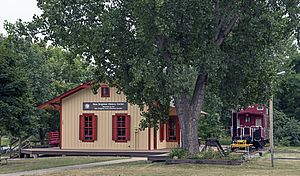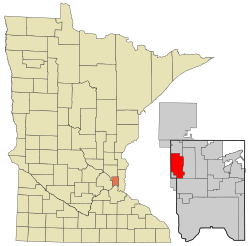New Brighton, Minnesota facts for kids
Quick facts for kids
New Brighton
|
|
|---|---|

New Brighton Area History Center
|
|
| Motto(s):
"building tomorrow today"
|
|

Location of the city of New Brighton
within Ramsey County, Minnesota |
|
| Country | United States |
| State | Minnesota |
| County | Ramsey |
| Incorporated | January 20, 1891 |
| Area | |
| • Total | 7.09 sq mi (18.35 km2) |
| • Land | 6.50 sq mi (16.82 km2) |
| • Water | 0.59 sq mi (1.53 km2) |
| Elevation | 866 ft (264 m) |
| Population
(2020)
|
|
| • Total | 23,454 |
| • Estimate
(2022)
|
22,413 |
| • Density | 3,611.09/sq mi (1,394.35/km2) |
| Time zone | UTC-6 (Central (CST)) |
| • Summer (DST) | UTC-5 (CDT) |
| ZIP code |
55112
|
| Area code(s) | 651 |
| FIPS code | 27-45430 |
| GNIS feature ID | 2395187 |
New Brighton is a city in Ramsey County, Minnesota, United States. It is a suburb of the Twin Cities area. In 2020, about 23,454 people lived there.
Contents
History of New Brighton
In the mid-1700s, Mdewakanton Dakota tribes lived near New Brighton's lakes. They gathered wild rice from the marshy areas. The Dakota people had a village near Long Lake and a smaller camp near Silver Lake Road.
In 1858, immigrants from Britain and France started a small village. It had a general store, a school, and a church. As railroads grew in the area, people from Minneapolis started the Minneapolis Stockyards and Packing Company in 1888. This company helped provide goods for homes, farms, and businesses.
Important people like Thomas Lowry and John Sargent Pillsbury were part of this company. As the village grew, it officially became a city on January 20, 1891. It was named New Brighton after Brighton, Massachusetts. Most of the first people in the city were English-American. Every August, the city celebrates its history with a festival called Stockyard Days at Long Lake Park.
In the early 1900s, the streetcar system expanded. This led to groups from Eastern Europe and Germany moving to New Brighton. People in New Brighton and St. Anthony still celebrate this heritage. They have an annual Polka Dance Party that started in 1892.
In the 1920s, a local farmer heard a rumor. He said that people who illegally sold alcohol had buried gold bars along Long Lake. This rumor caused a small "gold rush" as many people searched for the hidden treasure.
Geography and Landscape
New Brighton covers about 7.06 square miles (18.3 square kilometers). About 6.46 square miles (16.7 square kilometers) is land, and 0.60 square miles (1.5 square kilometers) is water. Rice Creek flows through the northern part of the city.
New Brighton is located where two major highways meet: Interstate 35W and Interstate 694. The city's shape is a bit uneven. A small part of the city is separated from the rest by Interstate 35W.
Nearby cities include Arden Hills, Shoreview, Roseville, Saint Anthony Village, Columbia Heights, Fridley, Mounds View, and Minneapolis.
New Brighton is on a flat area formed by glaciers. During the last glacial period, huge sheets of ice covered Minnesota. These glaciers were at least 0.62 miles (1 kilometer) thick. They shaped the land we see today, especially in Long Lake Regional Park. The last glaciers left about 12,000 years ago.
Because the land is still recovering from the weight of these glaciers, it doesn't drain water very well. This is why there are many lakes and rivers in the city. Long Lake itself was formed from a large chunk of ice left behind by a glacier. When the ice melted, it created the lake in the hole it left.
Population of New Brighton
| Historical population | |||
|---|---|---|---|
| Census | Pop. | %± | |
| 1890 | 355 | — | |
| 1900 | 350 | −1.4% | |
| 1910 | 375 | 7.1% | |
| 1920 | 368 | −1.9% | |
| 1930 | 500 | 35.9% | |
| 1940 | 658 | 31.6% | |
| 1950 | 2,218 | 237.1% | |
| 1960 | 6,448 | 190.7% | |
| 1970 | 19,507 | 202.5% | |
| 1980 | 23,269 | 19.3% | |
| 1990 | 22,207 | −4.6% | |
| 2000 | 22,206 | 0.0% | |
| 2010 | 21,456 | −3.4% | |
| 2020 | 23,454 | 9.3% | |
| 2022 (est.) | 22,413 | 4.5% | |
| U.S. Decennial Census 2020 Census |
|||
2010 Census Information
In 2010, New Brighton had 21,456 people living in 8,915 households. There were 5,731 families. The city had about 3,321 people per square mile (1,282 per square kilometer).
Most residents were White (84.2%). Other groups included African American (4.1%), Native American (1.4%), and Asian (4.8%). About 4.2% of the population was Hispanic or Latino.
The average age in New Brighton was 40.7 years old. About 21.1% of residents were under 18. About 17.7% were 65 years old or older. The population was almost evenly split between males (48.3%) and females (51.7%).
Education in New Brighton
New Brighton has four public schools. They are Bel Air Elementary School, Sunnyside Elementary, Highview Middle School, and Irondale High School. These schools are part of the Mounds View Public Schools (District 621).
Before 2005, there was also Pike Lake Kindergarten Center. It is now called Pike Lake Education Center and is a community education center.
Some students in New Brighton attend private high schools nearby. These include Totino-Grace in Fridley, Minnehaha Academy in Minneapolis, and Breck School in Golden Valley.
A small number of students in eastern New Brighton go to Mounds View High School. Also, a small part of New Brighton is served by ISD 282. Students in this area attend Wilshire Park Elementary and Saint Anthony Village Middle and High Schools in Saint Anthony Village.
Images for kids
See also
 In Spanish: New Brighton (Minnesota) para niños
In Spanish: New Brighton (Minnesota) para niños


